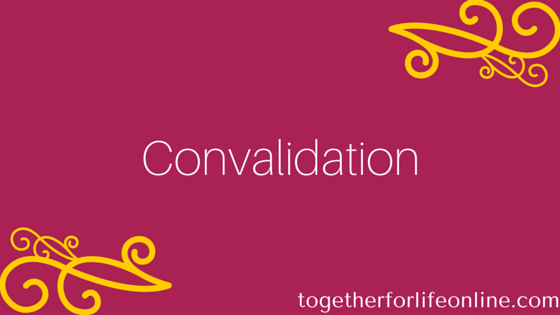
What is convalidation and how do couples plan a convalidation ceremony?
The Catholic Church believes that marriages entered into by non-Catholics in their particular church, or wherever they may take place, are valid. In the eyes of the Church, even two atheists or agnostics who are married civilly before a judge or magistrate enter into a valid marriage.
Convalidation Requirements: Catholics, however, are bound to observe a certain form of marriage ritual in order that their marriage be valid. Canon law—the law of the Church—requires that Catholics enter into marriage by free mutual consent that is witnessed in a church by an authorized bishop, priest, or deacon and at least two other witnesses. Marriages in which one or both parties are Catholic and which are not witnessed by an authorized bishop, priest, or deacon, or which do not receive proper permission to take place in another forum, are considered invalid in the eyes of the Church.
It may be that the Catholic who entered into marriage outside the Church did not realize that these requirements existed, but more often, it is because one or both of the spouses was not free to marry in the Catholic Church because of a previous marriage or because they were awaiting an annulment. Also, the Catholic partner(s) may not have been active in the Church and did not consider having a Catholic wedding.
Convalidation Wedding Ceremony
The Church very much wants to assist these couples who later want to enter into valid Catholic marriage, and it offers them pastoral and spiritual support as they need it. When these couples are ready and free to do so, they celebrate what is called a convalidation, from the Latin word meaning “to firm up” or “to strengthen.” This is sometimes referred to as the blessing of a marriage.
It is important to realize that a convalidation is not merely a renewal of vows made previously but is a new act of consent by each spouse. This new act of consent is essential to marriage, and the words that the couple expresses are the outward sign of the gift of self that they exchange. This convalidation of marriage may be celebrated within Mass or outside of Mass, again depending on the particular situation of the couple. If both are Catholic, it is fitting that the convalidation be celebrated within Mass. If one spouse is not, it is preferable that it be celebrated outside of Mass.
Customarily, since the couple’s married life is a known and public fact and may have been so for many years, a simple celebration with an invitation to close family and friends may seem more appropriate than a large celebration. Where appropriate, the priest or deacon who will witness the vows can help you use the Together for Life booklet to prepare the celebration.
This resource is an appendix of Together for Life. You can download the original article from the book here: “Appendix B: Having an Existing Marriage Blessed or Convalidated by the Church.”

